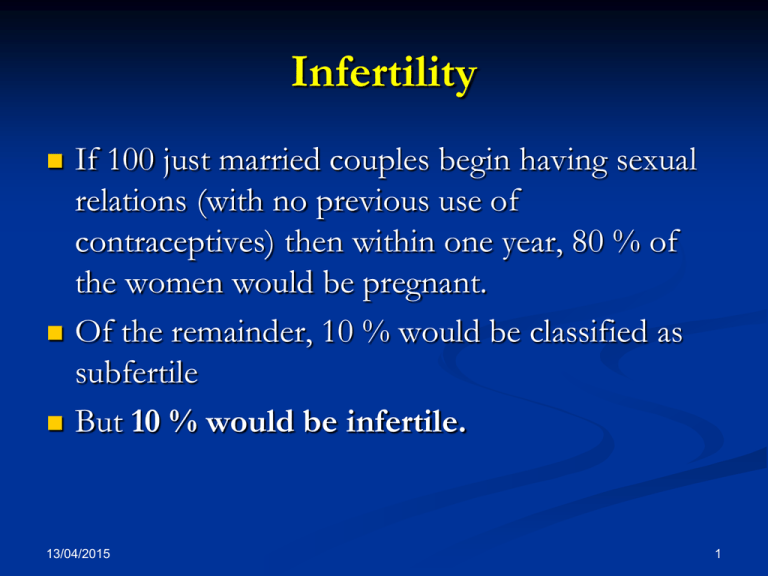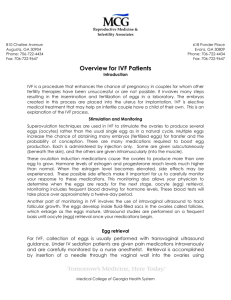IVF
advertisement

Infertility If 100 just married couples begin having sexual relations (with no previous use of contraceptives) then within one year, 80 % of the women would be pregnant. Of the remainder, 10 % would be classified as subfertile But 10 % would be infertile. 13/04/2015 1 Problems in the male account for 25% of cases of infertility In the female 40 % And combined male/female problems in the remaining 35%. 13/04/2015 2 Infertility is a growing problem. Some probable causes include; Delayed marriages and later childbearing Sexually transmitted diseases Pollution Diet Lack of exercise Previous contraceptive use leading to sterility Sterility from previous abortion Falling sperm count in males (medicines, alcohol etc) 13/04/2015 3 I.V.F. In Vitro Fertilization “Test tube babies” 13/04/2015 4 Louise Brown, 1978 5 Today there are more than 3 million IVF babies 13/04/2015 6 Success rate of IVF? Success rates vary and are often exaggerated To attract more clients Probably around 20-25 % successful 13/04/2015 7 How much does it cost? Average cost of total treatment $10,000 - $25, 000 (American dollars) Industry generates $ 2 billion per year. 13/04/2015 8 THE TECHNIQUE OF IVF 1. 2. 3. 4. There are generally four major steps in the process of IVF: Collect eggs from the woman Obtain sperm from the man In the laboratory place eggs and sperm together to allow for fertilization, to create embryos. (ICSI-Intra-cytoplasmic sperm injection since 1990’s.) Transfer embryos into uterus of woman 13/04/2015 9 THE TECHNIQUE OF IVF 4 2 1 3 13/04/2015 10 THE MORAL ISSUES The spread of technologies of intervention in the processes of human procreation raises very serious moral problems (Donum Vitae, Part III). 13/04/2015 11 1. Collect eggs from the woman The woman is given drugs to hyper-ovulate (produce many eggs). The drugs can cause side effects such as abdominal pain, nausea etc. 13/04/2015 12 2. Obtain sperm from the man Obtaining sperm by masturbation may be morally objectionable Sometimes donor sperm may be used 13/04/2015 13 3. In the laboratory place eggs and sperm together to allow for fertilization, to create embryos Embryos are created in the laboratory (the test tube) thus human fertilization occurs apart from sexual intercourse and outside the human body. 13/04/2015 14 The destruction of embryos Many embryos created. Healthy ones kept but defective embryos are destroyed. Healthy embryos can be transferred to woman or they can be frozen for use at later date. Sometimes they are experimented on. “ 13/04/2015r 15 The problem of frozen embryos In USA there are >400,000 frozen embryonic persons, a kind of “hell of ice”. In thawing them 50 % will die. Worldwide there are up to 1 million frozen embryos What to do with the frozen embryos? 13/04/2015 16 4. Transfer embryos into uterus of woman Many embryos implanted in mother’s womb (usually 2-4) to increase chance of pregnancy. Should too large a number of embryos start to grow, the ‘excess’ embryos are usually aborted (called “pregnancy reduction”). 13/04/2015 17











